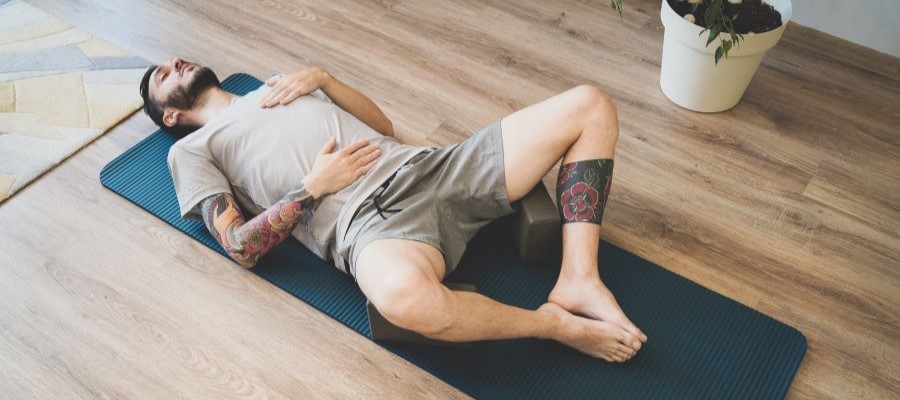Best Breathing Exercises for Sleep: Calm the Mind and improve sleep quality
Breathing exercises for sleep are a wonderful, drug-free way to help you fall asleep. When we breathe deeply and calmly, we enter the parasympathetic nervous system, which helps us release tension and reach a relaxed state. The effects of breathing exercises on anxiety has been confirmed by a meta analytic study review in 2021. Breathing techniques can also help with blood pressure, stress, and many other things.
Often, insomnia and stress are interlinked. If you suffer from a racing mind, deep breathing exercises can help clear your thoughts and feel calm so that you’re able to fall asleep more easily. Some health care systems even prescribe breathing exercises to patients. If you have trouble sleeping at night due to an overactive mind, try practicing one or all of these breathing techniques right before bedtime:
Preparations
Before going to bed, try practicing any of these relaxation techniques for about five minutes. Sit in a comfortable cross-legged position with your back straight and breathe deeply using either the nose or mouth — whichever is more soothing for you. Take full, deep breaths, activating both your rib cage (diaphragmatic breathing) and your belly (abdominal breathing).
You can also lay flat on your back (with your legs extended out) or lie down on one side while propping up your head with a small pillow. Keep your eyes softly closed and focus your attention on your breath. In each exercise, aim for about 5 second inhalations and exhalations to begin with.
The evening is actually the best time for deep breathing exercises because you are already lying down in a relaxed position. This will allow your body to become even more relaxed before falling into sleep mode.

The Box Breathing Exercise:
The box breathing technique – also known as square breathing – is great for calming the mind and body. To do it:
- Take a slow breath in through your nose while counting to five
- Hold that breath in for another count of five
- Slowly exhale through your mouth while counting to five
- Follow your exhale by holding again for another count of five before finally inhaling once more
Remember to use diaphragmatic breathing. Repeat this cycle to help your mind and body relax and unwind for the rest of the night. Aim for about nine repetitions to start with.
The Three Part Breath:
This technique is great for calming an overactive mind that keeps you awake at night:
- Inhale slowly into your belly for a count of five, then into your chest for another count of five, and finally into the top part of your lungs while counting to five.
- Hold that deep breath in for a final count of five before exhaling slowly through your mouth once more to complete one cycle.
The advantage of this exercise is the increased body awareness that it creates. This can have a very soothing physical and mental effect.
The Ocean Breath:
This breathing method is also known as ujjayi in yoga. It’s done by inhaling and exhaling slowly through your nose while constricting the back of your throat, which produces a soft sound that mimics ocean waves (hence the name).
An easy way to learn to constrict the back of your throat is imagining that you are breathing to fog a mirror, but with your mouth closed. This creates what is known as “ocean breath”.
Take deep and regular breaths, close your eyes and drift out on a calm sea.
The Alternate Nostril Breathing:

This last breathing technique is also known as Nadi Shodhana pranayama in yoga.
- To do it, begin by placing your right thumb on your right nostril and close off the airflow.
- Inhale slowly through your left nostril for a count of five while keeping your right nostril closed.
- Upon complete inhalation, release your thumb and use your right ring finger (or index finger, if that’s easier) to close off your left nostril while you exhale slowly through the right one (counting to five).
- Inhale again through the right nostril, then close the right nostril with your thumb, and exhale through the left.
Continue in this manner to help calm any racing thoughts that keep you up at night. Alternate nostril breathing is one of the most acclaimed relaxation techniques within yoga. A variety of this exercise where you breathe in through both nostrils is known as Anulom Vilom.
What’s the science behind breathing exercises?
Breathing exercises are part of the ancient sciences of yoga, ayurveda and qigong and are traditionally believed to work on many levels. Science has confirmed some of the effects of breathing exercises. For one, regular use slows down your heart rate and lowers your blood pressure. Breathing exercises also help regulate emotions and manage stress. Additional benefits include less snoring and daytime sleepiness. It should be noted that breathing exercises have not been studied exhaustively, and more research is needed to confirm several of the effects mentioned here.
Practice makes perfect!

If you want to feel the full effects of these breathing exercises, practice them regularly. Over time, it becomes easier and easier to use your deep breathing as a tool for relaxation — which means better sleep coming right up! Keep in mind that most of the studies referred to here on the benefits of breathing exercises studied regular practice. Give your practice a minimum of 6 weeks before evaluating.


